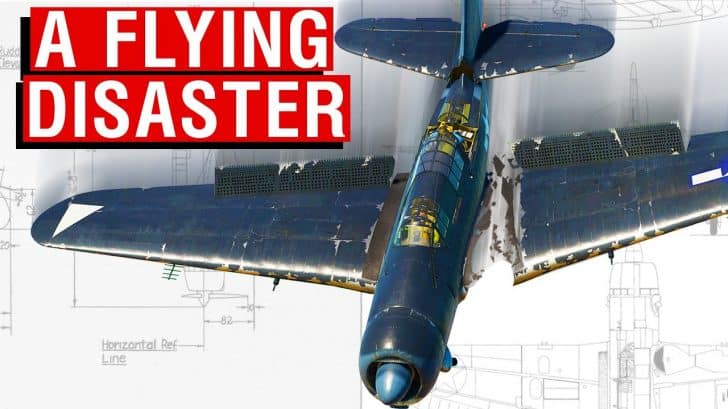The Helldiver is perhaps the best example of a potentially excellent aircraft design that was ruined by its uncompromising requirements. Here’s how:
Origins
Early in 1938, the US issued requirements for a diver that would be:
- Powered by the 1500 hp 14-cylinder Wright R-2600 Twin Cyclone,
- Carry a greater fuel load than the SBD Dauntless without drop tanks,
- Carry a 1,000-lb bomb internally,
- Compact enough to fit two of them onto the main elevator of US Navy fleet carriers

The last requirement was where it went wrong. The Navy basically asked to have an aircraft with greater internal capacity than anything built before while limiting the maximum external dimensions – these two features can be considered contradictory.
Prototype XSB2C-1
Ordered in 1939, the prototype was a two-seat monoplane dive bomber that featured an extensive hydraulic system. Armament consisted of two 50-cal machine guns in the nose, and two more 30-cal machine guns were mounted on a ring similar to the Dauntless.

Problems soon began before the prototype was even completed, however. In 1940, wind tunnel tests revealed unacceptably high stall speeds that made carrier landings dangerous. Furthermore, its shape and mass would cause it to accelerate excessively during dives.
Engine Problems
Initial versions of the Helldiver had performance problems, primarily related to its engine and handling characteristics.
The original powerplant, the Wright R-2600 Cyclone radial engine, suffered from reliability issues and inadequate power output, affecting the aircraft’s speed and climb rate. These deficiencies necessitated engine upgrades and other aerodynamic adjustments to enhance overall performance.

Because of the loss of the only prototype from trials and the aircraft’s questionable performance and structural integrity, the first 14 production Helldivers were retained for research development and testing.
Unending Loop Of Revisions
The features of a modern combat aircraft had already changed in 1942. The prototype didn’t have self-sealing fuel tanks, a DF loop, and armor protection for its crew, but the production SB2C-1s did. However, this meant it increased the empty weight from 7,122 lbs to 10,144 lbs, introducing another set of problems related to its performance.

In order to compromise, the armament was changed to four 50-cal machine guns on the wings and a single 50-cal at the back. Throughout 1943, a massive list of modifications began to build up, and a second production line had to be set up to update the earlier models to the revised specifications.

SB2C-1s came in a Mod 1, Mod 2, and Mod 3 variant. Surprisingly, the Mod 3 variant featured almost 900 design changes compared to its original design. It took until the 601st Helldiver to roll out of the factory before all previous models were finally brought up to standards.
The Beast
When it first entered service, the Helldiver already had poor power-to-weight performance, leaky hydraulic systems and fuel tanks, flaps that failed to retract, electrical systems that were seen as optional rather than mandatory, weak landing gear legs, and the early models also had poor directional stability.

The most significant improvement of the Helldiver came in the SB2C-3 variant, which featured an upgraded powerplant. The R-2600-20 version of the Twin Cyclone produced 1,900 hp, increasing its top speed from 281 to 294 mph. Other improvements later on, such as perforated flaps and dedicated dive breaks, improved low-speed handling, significantly reducing carrier landing accidents.



